13 Common Chicken Diseases And How To Treat Them
The sustainability of a poultry farming business boils down to how common chicken diseases are prevented and maintained. A lot of people give up on their poultry venture because of the challenges posed by the diseases.
With a good knowledge of the common chicken diseases likely to affect poultry production, you can ace your game in the business without having to cost an arm and a leg.
Whether you are raising chickens on a commercial note or for household benefits, there are major chicken diseases that are threats to your livestock’s productivity.
How to Prevent and Treat the 13 Most Common Chicken Diseases
We have detailed some of the very common chicken diseases, how to prevent them, and treatments to head on to in case your birds have already contracted any of them. We also added ideas on how to manage your chickens better.
1. Newcastle Disease

Newcastle disease is a viral respiratory disease of livestock. It is also a contagious infection and probably the deadliest chicken disease. It is easily observable from the murky look of the bird’s eyes, its breathing problems, and the mucus discharge from its nose. Sometimes, the bird may become paralyzed with a twisted neck.
An infected bird can easily pass this disease to other birds through the feeding trough, and other tools used to care for the chicken. Even as older birds carry this disease, they are most likely to recover but this is not the same for chicks as they would easily pack out.
To treat Newcastle disease in chickens, you should first isolate the bird to reduce the infection spread, then get a vaccine from a local pet store. This is usually the same strategy you use in treating most common chicken diseases.
2. Fowl Pox
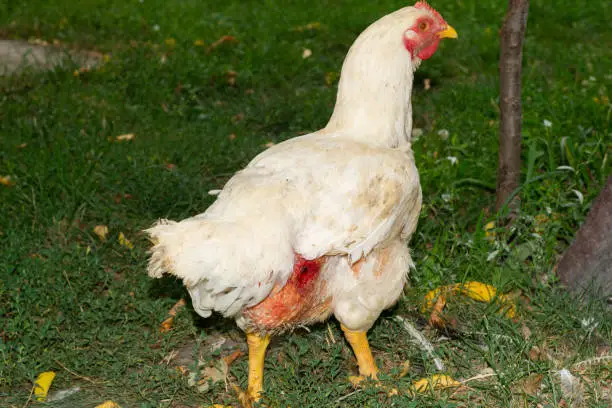
Fowl Pox is a poultry disease caused by the Avipox virus. Once you notice white spots and ulcers on the chicken’s skin and mouth, and scabby sores on their combs; then your birds are likely to have developed fowl pox.
Since the ulcerated spots are open, the infected birds can spread the disease to others on the poultry farm. This is one of the common chicken diseases that should seriously concern you especially if you notice that the bird’s laying pattern has stopped or changed.
Your birds would surely survive if you use the right vaccines, but while doing this, soft feed in a warm shelter is highly recommended. Prevention is another key treatment option for fowl pox; especially if you already have an infected bird on your farm. You can keep the rest of your livestock safe by vaccinating all the birds in the same poultry shed if possible.
3. Botulism
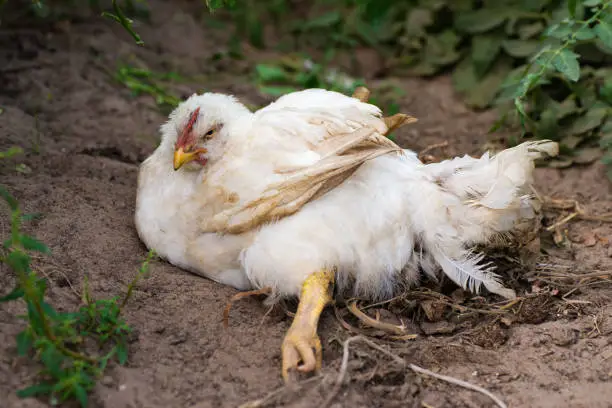
Botulism is one of the very common chicken diseases caused by the Clostridium botulinum bacterium toxin. This toxin affects all domestic fowl and most wild birds. Chickens would most likely contract this disease if they have been pecking dead meat left near their food or water.
It is indicated by tremors which progress into total body paralysis and breathing issues. You can also observe that the chicken’s feathers become very easy to pull. It is a serious chicken disease that kills birds in a few hours.
You can start treatments by cleaning up any dead carcass in your poultry and maintaining a clean environment around your farm. Just like it is caused by a toxin, the remedy would also be an antitoxin. If you spot the disease very early, you should mix a teaspoon of Epsom salts in 1-ounce (30mils) of warm water. Then administer to the birds using a dropper once daily.
4. Quail disease

The causative organism of quail disease is Clostridium colinum, which forms bacterial spores in the affected bird. A carrier bird spreads the infection through its droppings. The very alarming part of this common chicken disease is that the infected organism becomes resistant to disinfectants. This reaches up to such an extent that the bird thrives under varying environmental conditions.
Affected birds with the acute form of the bacterial rod die suddenly with good flesh. Birds with the chronic type, become listless with whitish watery diarrhea and ruffled feathers. These birds eventually die as they become extremely skinny and develop a humped-up posture.
To prevent this disease, you can raise your birds on a wire. However, if you suspect this disease in your poultry, first seek advice from a professional veterinarian. This would help specify if your birds have contracted Quail disease or if it was other common chicken diseases.
Then give bacitracin or penicillin. For bacitracin, mix 200 grams in a ton of the chicken feed and 1 teaspoon per gallon to the water. Administering bacitracin is sure to control the disease within two weeks but if the bird proves resistant to bacitracin, then you can use Penicillin for treatment. preventative measure.
5. Fowl Cholera

Fowl Cholera is caused by Pasteurella multocida which cab be contracted and spread from infected wild animals, food, or water. This disease should be suspected if your chicken begins to have greenish or yellowish diarrhea, darkened head or wattle, obvious joint pain, and breathing struggles.
You can vaccinate your chicken to prevent them from contracting most common chicken diseases, however, in this case, there is no actual treatment for fowl cholera. This is because birds that survive this disease remain carriers and may still pass it on to other birds. The only remedy becomes putting the bird down and burning the carcass to prevent the disease spread.
6. Infectious Coryza
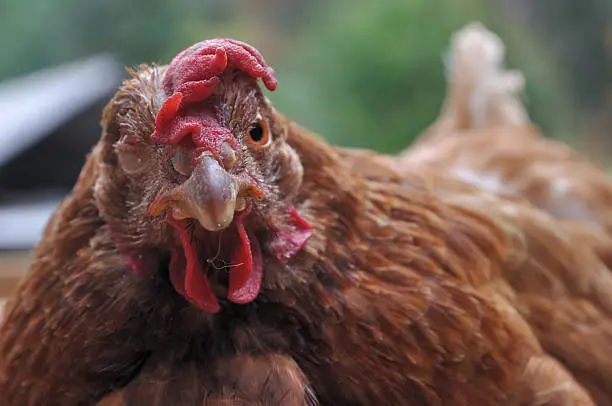
Hemophilus gallinarum is the bacterium that causes this disease. The symptoms include a swollen head, swollen combs, swollen eyes which now appear shut, mucus discharge from the eyes and nose, Moisture under the wings, and disturbed laying patterns.
Because there is no vaccine for this disease, you should kill and burn or bury any chicken that contracts this disease. If they are left to associate with other birds, this would increase the tendency of the disease to spread which is very fatal.
It would also be helpful to protect your chicken from random chickens that may be carriers of other common chicken diseases, then clean out their water trough, and coop.
7. Infectious Bronchitis

If you are new to raising chicken then you should watch out for this disease as it easily clears birds. It is caused by the Avian infectious bronchitis virus (IBV) and you can easily notice this when you hear your chickens coughing, sneezing, and snoring.
Of course, this is one of the common chicken diseases that is very easy to spot because just like a human being with a cold, it starts draining fluids from their nose and eyes.
To prevent Infectious Bronchitis you should administer vaccines in a warm, dry place. The virus can be destroyed with disinfectants and heat so you should increase the temperature of your brooding environment. Fresh herbs also help to clear mucus in the bird’s respiratory tract.
8.Thrush

Candida albicans is a yeast type that causes the fungal disease thrush. It is commonly contracted by a chicken that feeds on molded feed or from damp through. Thrush as a chicken disease is similar to that same thrush that affects human babies.
It can be recognized with a white substance oozing out from the crop of the chicken. The chicken becomes lethargic with a crusty vent area. Their feathers appear ruffled and their appetite becomes larger than normal.
This condition has no vaccine but can be controlled with anti-fungal medications. To effectively deal with this disease, you would have to start from the root cause, which is to remove the bad food and also the water containers.
9. Marek’s Disease
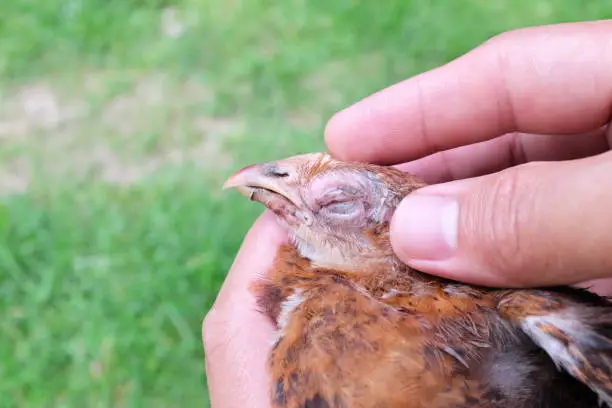
This viral disease of the Herpes virus group targets baby chicks most specifically birds younger than 20 weeks. The young bird seems to be blind because Iris turns grey and irresponsive to light. This in turn causes than to resort to being paralyzed. You will also notice that tumors are growing both inside and outside the chick.
The disease can be easily spread in the poultry by breathing in pieces of shed skin and feathers from an affected chick. Infected chicks remain carriers throughout life and the sincere remedy would be to put the chick down.
For prevention, you should give a vaccine for this to your day-old chicks.
10. Bumblefoot
Bumblefoot is regarded among the common chicken diseases that can be contracted through wounds, sores, or openings on the foot of the chicken. That is, as the bird feeds off the garden, it may cut itself through scratching or digging around the mulch and consequently gets infected. This is very obvious because the chicken’s foot and leg start to swell
Treatment is through surgery and if not properly done may claim the life of the chicken. The preventive measure would be to keep a close eye on the birds and disinfect them if there is any cut.
11. Air Sac Disease
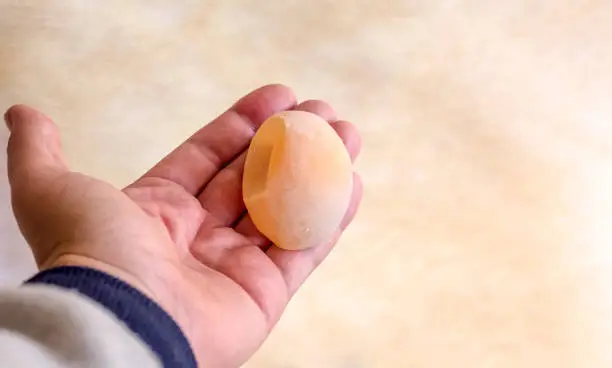
Air Sac Disease is caused by the organism Mycoplasma gallisepticum. It can be identified in a weak chicken that suddenly starts coughing and sneezing. Added to that, the chicken shows breathing problems, poor laying habits, swollen joints, and night resorts to death.
Wild birds can transmit this disease to your chicken and an infected hen can also transfer it to her chick through the egg.
To treat this infection, you can get a vaccine from a local vet store. Antibiotics are also key here.
12. Mushy Chick

Newly hatched chicks are the commonest victims of this disease. The chick appears drowsy and has an unpleasant odor. The midsection of the chick has a blue tint and is also inflamed.
This bacterial infection of the chicken occurs due to improper closure of the chicken’s navel. This can be traced to poor hatchery sanitation, faulty incubation, or chilling/overheating immediately after hatching. It can easily be spread from chick to chick in dirty poultry especially if the chick has a weak immune system.
There is no vaccine for this condition, however, antibiotics may subside. The more efficient control measure is to isolate the infected chicks from the healthy ones.
13. Coccidiosis

Coccidiosis is one of the common chicken diseases that can be identified from the loose droppings of the chicken. The parasite that causes this disease – Eimeria, damages the gut wall of the birds. This in turn results in bloody or watery diarrhea, ruffled feathers, and weight loss in your chickens.
The usual treatment for common chicken diseases would be to isolate the infected bird first and then go get a vaccine. For coccidiosis, your birds may become immune to a given species of the parasite but exposed to another. The medication for each kind varies and you may find out the specific type affecting your birds.
To prevent the spread of coccidiosis, vaccinate your chicks, add probiotic supplements to their food,
Conclusion
Even when poultry diseases can be devastating to such an extent that it clears your livestock, we are hopeful that through this article, you would have found out some of the precautionary measures to take to avoid the common chicken diseases likely to affect your birds.
